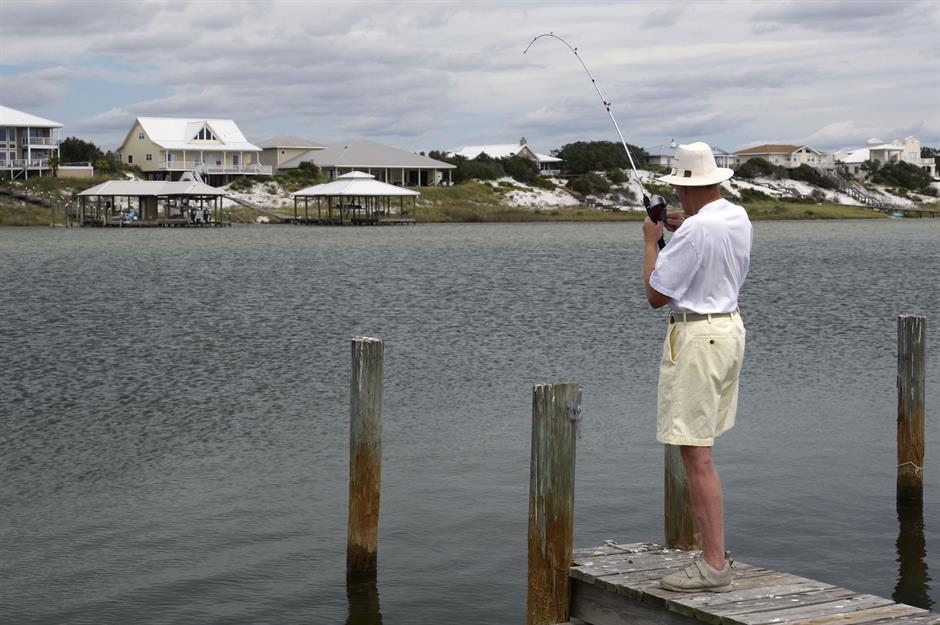Average retirement savings in each US state revealed
Nest eggs across America

More than 15 million older Americans are thought to be economically insecure, with at least 50% depending on social security for most of their income. How much money we set aside for retirement hugely affects our quality of life in later years.
Online wealth manager Personal Capital has worked out the average retirement savings of its millions of users by state. Read on to discover the surprising results.
Utah: $315,160

First up is Utah, where the typical saver has just $315,160 set aside for their golden years – the lowest average in America, according to Personal Capital. The state is unsurprisingly the least retirement ready and is considered to be only moderately tax friendly for retirees.
North Dakota: $319,609

North Dakotans are saving drastically less than residents of other states in the region. The average retiree has $319,609 set aside for their golden years – $130,000 less than their counterpart in neighboring South Dakota.
Mississippi: $347,884
Savers in Mississippi have just $347,884 put aside for retirement typically, but it's worth remembering that a little goes a long way down here. Not only does Mississippi have the lowest cost of living in the US – social security, retirement withdrawals and pension income are all tax-free.
Oklahoma: $361,366

Folk in Oklahoma have $361,366 on average saved for retirement but can live more comfortably than other Americans on very little income. Groceries and healthcare costs are among the cheapest in the nation, as are house prices.
Arkansas: $364,395

Arkansas residents save less on average for their twilight years than other Americans, and at 10.5% the state has one of the highest poverty rates for the over-65s. However, Arkansas is another state with a low cost of living, so seniors won't need as much saved up here.
Hawaii: $366,776

The typical resident of Hawaii has retirement savings of just $366,776, among the lowest in America. The state's high cost of living puts a squeeze on those trying to save money, and the government has created a task force to improve access to retirement savings plans.
However, for many people, Hawaii's weather and outdoor amenities make it the ideal place for retirement, especially for those with public pensions, which aren't taxed.
West Virginia: $370,532

Relatively few West Virginians are retirement ready. The typical saver in the state has amassed just $370,532 for their golden years, which is below the national average. To make matters worse, it's estimated that around half of private-sector workers in the state don't have an employer-sponsored retirement plan. While the state legislature has tried to pass bills establishing voluntary retirement account programs, they haven't successfully enacted one yet.
Tennessee: $376,476

Incomes in Tennessee are below the national average, households here having less cash to accumulate for retirement than those other states. The average retiree in Tennessee has put away just $376,476. But on the bright side, many retirement benefits such as social security are not taxed here, helping those with lower savings to stretch their cash a bit farther.
Nevada: $379,728

The savings situation is bleaker in Nevada, where living costs are significantly higher. Typically, people have $379,728 set aside in their later years, around $56,000 less than the national average.
Wyoming: $381,133

Average retirement savings may only amount to $381,133 in Wyoming, but it's one of the most tax-friendly states for retirees. And with a lower-than-average cost of living, retirement savings go a little further here compared to neighboring states.
New York: $382,027

Retirement savings are low in New York at $382,027, and residents here don't have the benefit of low living costs when it comes to setting aside extra cash for retirement. In fact, households in New York are among the least prepared for retirement in the Northeast, if not nationwide.
Louisiana: $386,908

Louisiana scores especially low for retirement readiness. Average savings amount to just $386,908, which may not be enough to pay for a comfortable retirement. And at 13.2%, the state's poverty rate for over-65s is the second highest in the US.
Montana: $390,768

Households in Montana also lack the retirement readiness found in other states. Average savings amount to less than $400,000. It's important to bear in mind, though, that living costs are economical in the sparsely populated state, which doesn't have any sales tax.
Rhode Island: $392,622

Residents of Rhode Island have saved $392,622 for retirement on average, which is less than in most states on the East Coast and below the national average. Only around half of the state's workers employed in the private sector have access to a retirement savings account. To combat this, legislators have tried and failed three times to enact a state-sponsored retirement program. State senators aren't giving up, having introduced a fourth bill back in January.
Alabama: $395,563

Retirement savings in Alabama are below the national average at $395,563, but the discrepancy is balanced out considerably by the relatively low cost of living. Housing costs and property taxes are relatively low, and very few retirement benefits are taxed here.
Maine: $403,751

Up in Maine, the typical saver has a total of $403,751 put away for retirement. It's one of the least tax-friendly states in America for retirees, which is surprising considering that it has the highest proportion of over-65s of any state. However, the affordable cost of living may help seniors' money stretch farther here.
Nebraska: $404,650

According to Personal Capital, the typical saver in Nebraska has $404,650 earmarked for their golden years. Nebraska has generally ranked as one of the less friendly states for taxing retirement benefits, and that's in addition to higher property and sales taxes. However, this spring the legislature eliminated state tax on social security.
Indiana: $405,732

It's estimated that around one-third of Indiana workers don't have any retirement savings, which may be part of the reason why their average savings – $405,732 – is on the lower side. However, those with income saved for their later years can stretch that money relatively far as the state is considered moderately friendly for retirees and the cost of living tends to be on the low side.
Missouri: $410,656

Missouri's lower-than-average household incomes don't do savers any favors, retirees having just $410,656 at their disposal, and 44% of private-sector workers don't even have access to a retirement plan. These two factors could explain why retirement savings here tend to be below the national average. However, Missouri is one of several legislatures that are considering implementing a state-sponsored savings program for people who don't have retirement benefits through work.
Arizona: $427,418

Similar progress is being made in Arizona's State Capitol. The governor signed a bill this spring establishing a study group to weigh up all the options for providing private-sector workers with access to a retirement plan. While the state is well known as a retirement hotspot, the amount of money that people are setting aside for later life is typically below the national average at $427,418.
Ohio: $427,462

It's estimated that 70% of small businesses in Ohio, which employ around 2.5 million people across the state, don't offer a retirement plan. With lower household incomes, it's not surprising that those who are saving here have slightly less than the national average set aside at $427,462.
New Mexico: $428,041
Down in New Mexico planning for retirement leaves much room for improvement. The poverty rate among people over age 65 is the highest in the country at 13.5%, and two-thirds of private-sector workers have nothing saved for retirement. That said, those who are setting aside money for later in life have only slightly less than the national average, at $428,041.
Florida: $428,997

Think retirement and Florida is more than likely to spring to mind. Florida has a higher proportion of seniors than any other state – but the typical retirement savings are not as outstanding at $428,997. However, for retirees the state is very tax friendly.
Texas: $434,328

Texan retirees typically have $434,328 saved up, which is just above the national average of $429,525. However, the state does have a high poverty rate for seniors at 10.6%, and AARP reports that two-thirds of private-sector workers don't have an employer-offered retirement plan, which could be problematic in the years to come.
Georgia: $435,254

Georgia is one of America's more retirement-ready states according to data from Personal Capital. Retirees have average savings of $435,254. Thanks to Georgia's low cost of living and pro-senior taxation stance, money saved for your golden years goes far here.
Idaho: $437,396

Idaho's savers are more financially prepared for retirement than many other Americans. The typical resident has a not-too-shabby $437,396 saved up for their golden years, a decent amount for a state with low living costs.
Michigan: $439,568

While the average Michigan retiree has more than their counterpart in Idaho at $439,568, this doesn't go as far. And a survey by the Pew Research Center found that workers here generally report lower confidence than those in other states that they will have the resources to live comfortably after retirement. However, they also reported that they generally expect to retire earlier than the typical US worker.
Kentucky: $441,757

Over the last decade Kentucky has struggled to fund its state pension system, which has a shortfall of at least $43 billion. The state already has one of the highest poverty rates for seniors at 11.6%, which jumps to nearly 20% for Black residents, alongside higher rates of food insecurity among over-50s.
At the same time, those who can save are likely to maintain a comfortable lifestyle. According to Personal Capital, retirement savings average out at $441,757 here.
Wisconsin: $448,975

Wisconsin is one of America's more retirement-ready states. The average saver has $448,975 set aside for later in life, and that's likely to go further here with the state's lower living costs typical of the Midwest. Plus the state doesn't tax social security or income from public pensions.
South Carolina: $449,486

Seniors are set to enjoy the good life in South Carolina. The typical retirement savings are about $20,000 higher than the national average at $449,486, and savers can rest assured their money will go farther here than in other states. South Carolina has a relatively lower cost of living and is one of the more tax-friendly states when it comes to retirement income.
South Dakota: $449,628

South Dakota is even friendlier for seniors with all retirement income tax free. The typical savings here of $449,628 is over $100,000 higher than the average in neighboring North Dakota, making residents here some of the most prepared for retirement in the region.
Colorado: $449,719
Colorado is considered a friendly state for retirees, offering everything from excellent healthcare to growing retirement communities. The cost of living is rather high compared to the rest of the region, so it's a good thing residents average a healthy $449,719 in retirement savings.
Illinois: $449,983

Likewise, savers in the state of Illinois tend to have more cash earmarked for retirement than many other Americans, averaging $449,983. Most retirement income is tax-free here, although property and other taxes are among the highest in the nation.
California: $452,135

The cost of living is notoriously high in California, but wages are generous and household income above average. The typical retirement saver in the state has managed to amass just over $450,000, which, as you'd expect, tops the nationwide average.
Oregon: $452,558
Everything from housing to taxes is on the steep side in Oregon, so an above-average retirement savings figure of $452,558 may not go so far here. However, the state employee pension plan has a healthy fund in place, exceeding $100 billion last year.
Kansas: $452,703

With average savings of $452,703, and an incredibly low cost of living, Kansas retirees are prepared for their golden years. Although many may not have thought so until recently. With shortfalls in the last few years, the state could only cover 64 cents to every dollar owed to those in Kansas' public employee pension fund. Legislators approved a measure this spring to transfer $1 billion of state money to help cover the debt and begin closing the funding gap.
Delaware: $454,679
Unlike other states in the northeast, Delaware is a tax paradise for savers and seniors alike. The cost of living may be high, especially when it comes to staples like groceries, but households bring in slightly above-average incomes. Typical retirement savings are healthy, averaging $454,679.
Pennsylvania: $462,075
Considered a tax-friendly state for seniors, Pennsylvania offers the average saver $462,075 for later life – and retirees can enjoy this in good company. Pennsylvania has one of the highest percentages of residents over the age of 65, and this is expected to grow speedily in the coming years.
North Carolina: $464,104

Citizens of North Carolina are among the best prepared for retirement in their region. Savings average out at $464,104 in the state – at least $36,000 above what Americans have typically saved. However, pension income, both public and private, is taxed.
Iowa: $465,127

Iowans have decent savings at $465,127 on average, and this money will go far. The state has the lowest cost of living in the region and only partial taxes on retirement income. Social security is tax-free here too. Although it's worth noting Iowa is one of several states with an inheritance tax.
Washington: $469,987
Washington may be a low-tax state, but living costs are high, putting a squeeze on residents' finances. Consequently, the above-average retirement savings, typically around $469,987, may not go as far as smaller savings do in other states.
Minnesota: $470,549

Compared to their neighbors, Minnesotans have the highest incomes, along with higher living costs. Despite this, savers manage to set aside $470,549 on average, more than any other state in the Midwest. However, this is one of the most unfriendly states for seniors when it comes to taxes.
Massachusetts: $478,947

Living costs aren't cheap in Massachusetts either, but household incomes are among the highest in America, providing lots of extra cash to set aside. The average retiree saves a hefty $478,947.
Maryland: $485,501

The cost of living is high in Maryland too, so residents of the state need to accumulate a considerable sum of cash for a comfortable retirement – and many do, if the average savings figure of $485,501 is anything to go by. The state pension fund alone is worth nearly $67 billion.
Virginia: $492,965

With its proximity to Washington, DC, many Virginians make good money. And with the cost of living slightly cheaper here than in Maryland, residents can stash away a little more retirement cash on average.
Vermont: $494,569

Vermont is an old state, and not just in terms of its founding date. It's second to Maine when it comes to median age and an estimated 42% of residents are at least 50 years old. According to Personal Capital's survey, people in the baby boomer generation here have an average retirement balance of more than $1 million, whereas millennials are more likely to have around $178,000. So it may be that with fewer younger residents the average saving is skewed higher here.
Alaska: $503,822

Typical retirement savings are well above the nationwide average up in Alaska – a cool $503,822. While taxes are low here, the cost of living is high. Expenses can be especially steep when it comes to housing and healthcare, meaning that retirees will need more money to get by than their counterparts in other states.
New Hampshire: $512,781

New Hampshire does have a slightly higher-than-average cost of living, but there's no sales tax and no tax on social security. This means the healthy half a million dollars saved up for later life will keep the average retiree comfortable.
New Jersey: $514,245

New Jersey has a higher percentage of millionaires calling the state home than anywhere else in America. While it can be an expensive place to live, this is offset by high household incomes. Unsurprisingly, NJ residents have managed to accumulate the second-largest average savings at $514,245.
Connecticut: $545,754
Clinching the top spot for retirement savings, Connecticut offers the highest average retirement savings – a colossal $545,754. This means that the typical retiree has a quarter million dollars more set aside than their Utah counterpart.
Retirees in Connecticut require plenty of cash to cover the state's high taxes and cost of living. Luckily, salaries are among the highest in the US and, as a result, people in work tend to save much more money for later life than other Americans.
Now discover the US states where people are drowning in debt
Comments
Be the first to comment
Do you want to comment on this article? You need to be signed in for this feature